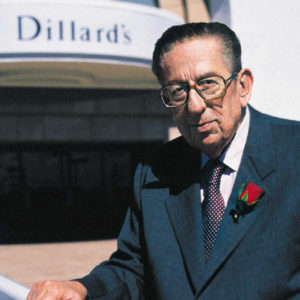calsfoundation@cals.org
Dillard's, Inc.
Dillard’s, Inc., based in Little Rock (Pulaski County), is ranked among the nation’s largest fashion apparel, cosmetics, and home furnishings retailers, employing more than 53,000 people across the country. The mid-range-to-upscale department store chain consists of approximately 300 stores throughout twenty-nine states in the South, Southwest, West, and Midwest. In the twenty-first century, Dillard’s stores serve as retail anchors in many suburban shopping malls and continue to evolve with the changing landscape of American consumerism.
Born in 1914, Dillard’s founder William T. Dillard grew up in the retail business of his father’s mercantile store in Mineral Springs (Howard County). After his graduation from the University of Arkansas (UA) in Fayetteville (Washington County) in 1935, followed by a graduate degree from the School of Business at Columbia University in New York in 1937, he completed the Sears management training program in 1938. Dillard decided to go into business for himself, opening the first Dillard’s store—called “T. J. Dillard’s”— in Nashville (Howard County) using $8,000 in startup capital that he borrowed from his father.
During World War II, Dillard sold his store, but shortly after the war, he reopened and expanded it. Once the Nashville store was profitable, he expanded into nearby Texarkana (Miller County) by becoming a partner in Wooten’s Department Store. After selling his Nashville store and buying the remaining half of the Wooten Department Store in 1949, the store became profitable within three months.
In the 1950s, Dillard began the acquisition and expansion phase of the company, which would last for the next four decades. His strategy of purchasing hometown department stores that were in financial trouble based upon their location rather than the products they sold quickly became his trademark move. He obtained stores in Texas and Oklahoma, quickly turning profits and paying down acquisition-related costs. In 1961, to draw in more customers, the company established a credit subsidiary, Dillard Investment Company, Inc., which gave customers access to credit while allowing the company to remain free of credit debt.
In 1964, several important changes occurred in the company, including the introduction of the first mall location, in Austin, Texas. After this store’s opening and significant success, the aggressive trend of suburban mall expansion would become pivotal to Dillard’s success, continuing well into the 1990s. Also in 1964, Dillard relocated his family and the company’s headquarters to Little Rock, incorporating his company as Dillard’s, Inc.
Dillard’s employed several trademark techniques and strategies as it grew. It became one of the first companies to implement a centralized computer system to help track inventory and sales, which streamlined Dillard’s buying power and progress. Rather than using discount sales, the company relied more on loyalty to maintain the customer base of its stores. A local focus, with advertisements in local media outlets and pricing strategies based on local competition, combined with its computerized inventory and sales system, enabled Dillard’s to become a cornerstone in many suburban malls and secondary markets.
In 1969, Dillard’s, Inc., went public on the New York Stock Exchange under the index DDS, publicly offering Class A Common Stock, which would help raise money for further acquisitions. Class B, or voting, stock remained under Dillard family control.
During the 1970s, acquisitions continued, especially in Texas. The company explored the market in southern Texas, even accepting pesos at several stores along the Texas-Mexico border. Dillard’s purchased five Leonard’s stores from the Tandy Corporation, which provided exposure in the Dallas–Fort Worth market. In 1974, a Dillard’s store replaced the Pfeifer-Blass store as one of the anchors of McCain Mall in North Little Rock (Pulaski County).
In 1977, William (Bill) Dillard II, William Dillard’s son, was named president and chief operating officer, with William Dillard remaining chief executive officer and chairman of the board. Profits, as well as debts, doubled during the 1970s. Interest rates began to rise in the early 1980s, but the company continued to return considerable profits, so much so that the stock split twice during that decade.
During the 1980s, several major acquisitions increased its market outlets, including that of the Stix, Baer & Fuller stores in St. Louis and Kansas City, Missouri, in 1983. The company also bought the Dayton Hudson department store divisions in 1984, giving Dillard’s locations in Oklahoma, Arizona, and Nevada. To expand the company’s holdings in the Midwest, twelve Macy’s department stores, twenty-seven Joske’s department stores, and three Cain-Sloan units were purchased in 1986 and 1987. During the next two years, inroads were made into Ohio by the purchase of a half interest in the Higbee Department Stores, and in Florida, North Carolina, and South Carolina with the procurement of twenty-three J. B. Ivey stores.
Due to a lack of available properties, Dillard’s acquisitions slowed somewhat in the early 1990s. Instead, the company focused on construction and expansion of existing stores. Sixty new Dillard’s department stores were built during the decade, and numerous stores were either expanded or remodeled. The largest acquisition came in 1998, with the purchase of 103 stores from Mercantile Store Company, Inc., based in Cincinnati, Ohio. After selling some stores due to overlapping markets, Dillard’s retained seventy-five of the original locations.
At the beginning of the twenty-first century, after the Mercantile acquisition, the company began to post low profits for the first time in its history, which caused some panic among investors, coupled with uncertainty brought on by the greater overall national and global economic recession. In an effort to rebound, the company cut operating costs, sold off underperforming stores, and ridded itself of non-core operations. In 2004, it sold its ticket sales operation, Dillard’s Box Office, to EMT Entertainment Network of California and its credit card subsidiary, Dillard Investment Company, to GE Consumer Finance; its travel agency, Dillard’s Travel, was sold in 2008. The company also faced shareholder disapproval over family ownership and special treatment, active insider trading issues, and ongoing discrimination lawsuits. These issues have affected the company’s bottom line as well as its reputation.
Dillard’s founder William T. Dillard died on February 8, 2002, at the age of eighty-seven. From a small department store in Nashville, he helped build one of the fastest-growing department store chains in the United States.
In late 2020, the U.S. Equal Employment Opportunity Commission filed a racial discrimination lawsuit against Dillard’s, in which it was alleged that the retailer did not promote Black workers to managerial positions on the basis of their race. While the company insisted it had done nothing wrong, it nonetheless agreed to a consent decree and paid $900,000 to settle all claims.
For additional information:
Rosenberg, Leon Joseph. Dillard’s: The First Fifty Years. Fayetteville: University of Arkansas Press, 1988.
Dianna Owens Fraley
Couch, Missouri
 William T. Dillard
William T. Dillard  Dillard's, Inc., Headquarters
Dillard's, Inc., Headquarters 




Comments
No comments on this entry yet.